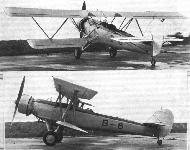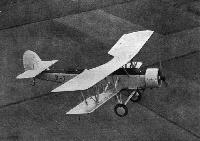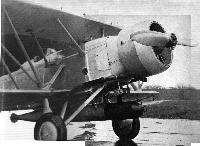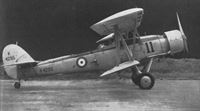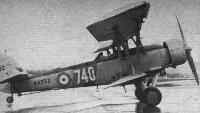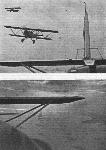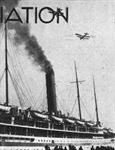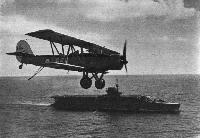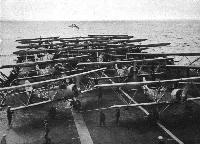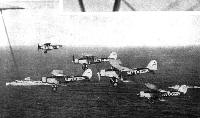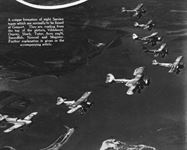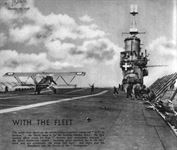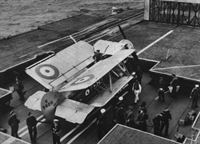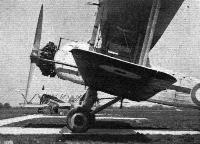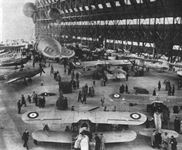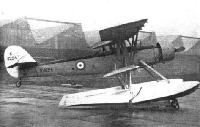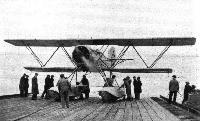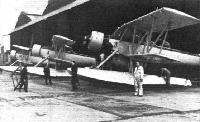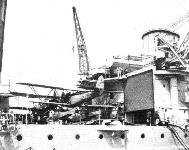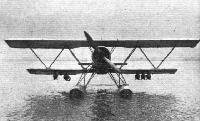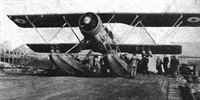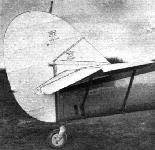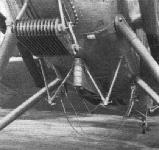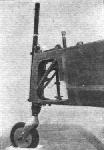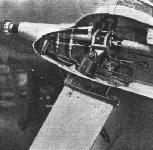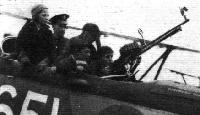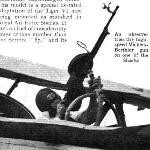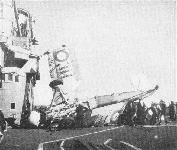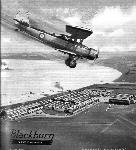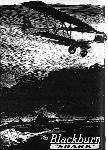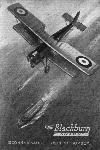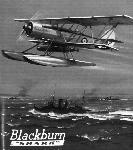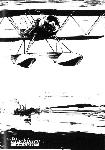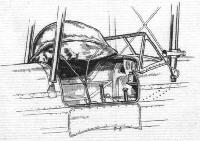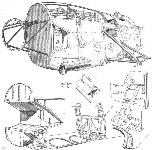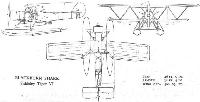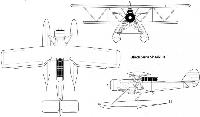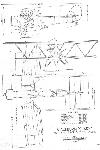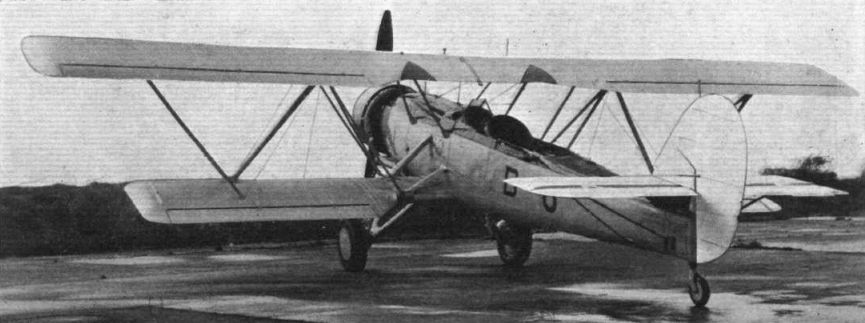
Описание
Страна : Великобритания
Год : 1933
Двух- или трехместный торпедоносец, бомбардировщик, разведывательный самолет корабельного или наземного базирования
Shark / B-6
Разведчик, бомбардировщик и торпедоносец. Одномоторный цельнометаллический биплан. Шасси сменное: колеса или два поплавка. Создан в КБ "Блэкберн эйрплейн энд мотор компани" (с 1936 г. именовалась "Блэкберн эйркрафт") как палубный бомбардировщик-торпедоносец. Опытным образцом "Шарка" являлся самолет В-6 (Т.9), впервые поднявшийся в воздух 24 августа 1933 г. на колесах. С декабря 1934 г. "Шарк" серийно строился на заводах "Блэкберн" в Бру и Дамбартоне, а с июля 1939 г. - также на предприятии фирмы "Боинг оф Кэнеда" в Ванкувере. Всего выпустили 265 экз. (в т.ч. 17 в Канаде).
На поплавки "Шарк" впервые поставили в апреле 1935 г., превратив его в катапультный разведчик для крупных боевых кораблей. С мая 1935 г. часть самолетов стала собираться на поплавковом шасси.
"Шарк" состоял на вооружении в Великобритании с мая 1935 г., в Канаде и Португалии - с 1936 г.
Экипаж - 3 чел. Двигатель - в зависимости от модификации. Вооружение 2x7,69, бомбы до 750 кг или одна торпеда (680 кг).
Серийно выпускались следующие модификации:
- "Шарк" I (Т.9) с мотором "Тайгер" IV;
- "Шарк" II (Т.9А) с мотором "Тайгер" VIC; экспортные самолеты модификации НА имели дополнительные бензобаки;
- "Шарк" III (T.9B) с закрытой кабиной; машины канадской постройки с мотором "Пегасус" IX, последние самолеты - с округлым рулем поворота.
С июля 1938 г. завод в Дамбартоне дорабатывал "Шарк" II под стандарт модификации III.
Поплавковые самолеты "Шарк" появились на линкорах и крейсерах британского флота с начала 1937 г., но уже с ноября начали заменяться более современными типами машин. С ноября 1937 г. их стали использовать для буксировки мишеней для тренировки зенитчиков. На береговых базах "Шарк" служили до начала Второй мировой войны. В июне 1940 г. как разведчики и самолеты связи они участвовали в организации эвакуации английских войск из Дюнкерка. Небольшое количество машин этого типа действовало с Мальты в начале обороны острова, а также отражало высадку японского десанта в Малайе в декабре 1941 г.
Канадские "шарки" с сентября 1939 г. патрулировали побережье Британской Колумбии. В октябре 1942 г. "Шарк" III атаковал немецкую подлодку.
Производство самолетов прекратили в Англии в декабре 1937 г., в Канаде - в апреле 1940 г. Британский флот снял "Шарк" с вооружения в 1942 г. В Канаде они до 1944 г. эксплуатировались как учебные. В июне 1944 г. канадцы передали самолеты англичанам; их использовал учебный центр на о. Тринидад.
"Шарк" III||
Размах:||14,02 м
Длина:||11,71 м
Моторы, количество х мощность:||1х 746 л. с.
Взлетная масса, максимальная:||3750 кг
Максимальная скорость:||230 км/ч
Практический потолок:||4650 м
Дальность:||1835 км (с дополнительным баком)
Описание:
- Shark / B-6
- Blackburn В-6 Shark
- Flight, May 1934
THE BLACKBURN T.S.R. - Flight, June 1934
Blackburn B. 6 - Flight, December 1934
THE BLACKBURN "SHARK" - Flight, March 1935
THE BLACKBURN T.S.R. SEAPLANE - Flight, May 1935
A NEW BLACKBURN "G.P."
Фотографии
-
Flight 1934-06 / Flight
Blackburn T.S.R. (Armstrong-Siddeley "Tiger" engine).
-
Flight 1935-05 / Flight
Another view of the wing bracing is obtainable in the side elevation.
-
Flight 1935-05 / Flight
Blackburn "G.P."
-
Flight 1935-05 / Flight
The Blackburn G.P. machine is almost a "sesquiplane" in that the lower wing is much smaller than the upper. Note the unusual wing bracing.
-
Flight 1936-04 / Flight
The nose of the Blackburn "Shark" "Tiger"-engined T.S.R. biplane, showing how the 18-inch torpedo is carried and how the 760 h.p. 14-cylinder Tiger is fitted with the long-chord Siddeley cowling.
-
Flight 1934-12 / Flight
NOTEWORTHY: A three-quarter front view of the "Shark," which shows clearly the strut bracing of the wings.
-
Flight 1938-04 / Flight Advertisements
Регистрационный номер: K4295 [4] -
Flight 1934-08 / Flight
Регистрационный номер: K4295 [4] THE BLACKBURN T.S.R.: The letters stand for torpedo, spotting, reconnaissance and the engine is a Siddeley "Tiger."
-
Aviation Historian 11 / M.Willis - From Farmer to Test Pilot /Duncan Menzies/ (1)
Регистрационный номер: K4349 The first production Blackburn Shark, K4349, the aircraft in which Menzies made a skilful forced landing in a field during a ferry flight in December 1934.
-
Flight 1935-12 / Flight
Регистрационный номер: K4352 The first torpedo spotter reconnaissance machine to go into service with the R.A.F. is the Blackburn Shark (760 h.p. Tiger).
-
Авиация и Космонавтика 2022-02 / В.Морозов - "Битва" за Сингапур (2)
Регистрационный номер: K4880 Английский разведчик-торпедоносец Блэкберн «Шарк» на колесном шасси. Юго-Восточная Азия. Фото предвоенных лет
-
Flight 1936-06 / Flight
Регистрационный номер: K4882 THE SAME - BUT DIFFERENT. The version of the Blackburn Shark T.S.R. to be flown at the Hatfield Display on Monday, will differ somewhat from that now in service with the Fleet Air Arm. The engine is a 600 h.p. Pegasus III and cockpit enclosures are incorporated - and very neatly too, judging from this photograph.
-
Aeroplane Monthly 1990-05 / Personal album. Military
Регистрационный номер: K8900 Blackburn Shark III K8900 was one of a batch of 45 aircraft supplied to the RAF between March and July 1937. It served with Nos 810 and 822 Sqns before joining C Flight at RNAS Ford.
-
Jane's All the World Aircraft 1938 / 03 - All the world's aeroplanes
Регистрационный номер: L2351 The Blackburn "Shark" Torpedo-Spotter-Reconnaissance Biplane (Armstrong Siddeley "Tiger" engine).
-
Flight 1939-07 / Flight
Регистрационный номер: K8518 A flight of Skuas over Lee-on-the-Solent. In the foreground are Sharks.
Другие самолёты на фотографии: Blackburn Skua / B-24 - Великобритания - 1937
-
Flight 1937-05 / Flight
(Top) Two Blackburn Sharks of the T.S.R. squadrons. Coming up astern is an impressive formation of fleet fighters - Hawker Ospreys and Nimrods. (Lower picture) "Long lines of British and foreign warships appeared out of the haze." The aircraft carriers are distinguishable.
-
Flight 1940-10 / Flight
A formation of Blackburn Sharks. They belong to a class of aircraft known as "T.S.R.," the letters indicating that the duties include torpedo-dropping, spotting, and reconnaissance.
-
Flight 1938-03 / Flight
A Swordfish and a Shark dip over the troop transport bearing R.A.F. units to eastern parts.
Другие самолёты на фотографии: Fairey Swordfish - Великобритания - 1934
-
Flight 1937-05 / Flight
Регистрационный номер: K8454 FOR ROYAL REVIEW: H.M.S. Courageous, which, together with Glorious and Furious, will be among the 277 vessels assembled at Spithead for the Royal Review to-day, Thursday. The aircraft is a Blackburn Shark T.S.R. with Siddeley Tiger engine.
-
Мировая Авиация 54
Прототип самолета модели Shark, изображенный здесь, был в основном идентичен серийным машинам модификации Mk I. Обратите внимание на подвешенную под фюзеляжем 680-кг торпеду.
-
Flight 1937-06 / Flight
"The aircraft to be flown-off are brought up on the lifts from the hangars below decks and are ranged up behind each other on the flight deck. Often two or more squadrons are so ranged up at the same time." Sharks and Baffins are seen in this striking photograph taken on board H.M.S. Courageous.
Другие самолёты на фотографии: Blackburn Baffin / B-5 - Великобритания - 1933
-
Flight 1938-05 / Flight
Регистрационный номер: K8468 [2] BLACKBURN SHARK: Torpedo-spotter-reconnaissance (Tiger VI engine - 810 h.p. at 5,000ft.); span, 46ft.; gross weight, 7,870 lb.; max. speed, 152 m.p.h. at 5,500ft.
-
Air-Britain Aeromilitaria 1981-02
Регистрационный номер: K8468 [2], K8471 BASKING SHARKS: Egyptian sunlight lends a particular charm to this view of Blackburn Shark T.S.R.s (Siddeley Tiger VI engine) from H.M.S. Courageous over Aboukir, the coastal town and R.A.F. base near Alexandria.
The Blackburn Sharks of No.820 Squadron from HMS Courageous over Aboukir in February 1937. Note the four Valentias to the right of the dividing road and railway. -
Flight 1937-11 / Flight
Blackburn Shark torpedo spotter reconnaissance machines of the Fleet Air Arm with a Blackburn Baffin torpedo bomber beyond.
Другие самолёты на фотографии: Blackburn Baffin / B-5 - Великобритания - 1933
-
Aeroplane Monthly 1994-12 / G.Wansbrough-White - What's in a name? (2)
A formation of eight types based at Gosport in 1938. They are, from the top, Vildebeest, Osprey, Shark, Tutor, Avro 504N, Swordfish, Nimrod and Magister. The 504N was flying at full bore while the Kestrels of the Nimrod and Osprey were throttled well back. Pilots of this “Heinz” formation were drawn from the RAF, Army, Navy and Marines; the aircraft came from the Coastal Defence Development Flight and the Torpedo Training Unit.
Другие самолёты на фотографии: Avro Avro 504N - Великобритания - 1920Avro Tutor/Sea Tutor/Prefect / Type 621/646/626 - Великобритания - 1929Fairey Swordfish - Великобритания - 1934Hawker Nimrod - Великобритания - 1931Hawker Osprey - Великобритания - 1930Miles Magister / M.14 - Великобритания - 1937Vickers Vildebeest / Type 132 - Великобритания - 1928
-
Flight 1938-05 / Flight
A unique formation of eight Service types which are normally to be found at Gosport. They are, reading from the top of the picture, Vildebeest, Osprey, Shark, Tutor, Avro 504N, Swordfish, Nimrod and Magister.
Другие самолёты на фотографии: Avro Avro 504N - Великобритания - 1920Avro Tutor/Sea Tutor/Prefect / Type 621/646/626 - Великобритания - 1929Fairey Swordfish - Великобритания - 1934Hawker Nimrod - Великобритания - 1931Hawker Osprey - Великобритания - 1930Miles Magister / M.14 - Великобритания - 1937Vickers Vildebeest / Type 132 - Великобритания - 1928
-
Flight 1939-05 / Flight
The Blackburn Shark is seen just before touching down and engaging its arrester hook with the transverse wires on the deck.
-
Flight 1938-01 / Flight
The white cross shows on the carrier's superstructure, signifying "O.K. to land on"; the Shark noses in for the landing, touches down; the deck landing officer raises his flags ("Arrester gear successfully engaged"); the Shark decelerates rapidly; handling crews shepherd her to the lift; latch pins are withdrawn, the wings fold back; and down goes the Blackburn into the bowels of the "Courageous."
-
Flight 1938-01 / Flight
Регистрационный номер: K5620 -
Flight 1936-09 / Flight
GOSPORT CAMEO: A Blackburn Shark (Siddeley Tiger) and a Vickers Vildebeest (Bristol Pegasus) used for development work with torpedoes at Gosport. Both types (classed officially as torpedo bombers), although well established in service, are still in quantity production. Certain Vildebeests are receiving Perseus sleeve-valve engines.
Другие самолёты на фотографии: Vickers Vildebeest / Type 132 - Великобритания - 1928
-
Flight 1939-07 / Flight
Observers studying courses, with a Shark waiting in the background.
-
Flight 1940-08 / Flight
THE KING WITH THE FLEET AIR ARM: His Majesty inspecting air crews at a south coast naval port recently. The machine in the background is a Pegasus-engined Blackburn Shark.
-
Flight 1938-06 / Flight
Lighter-and-heavier-than-air Day in the big hangar at Cardington. In this non-stop variety picture are barrage balloons, a Blenheim and a Battle (left), a new Hind Trainer (foreground), Hector, Shark, Swordfish and Cloud (right), not to mention other less discernible aircraft and a goodly proportion of the population of Bedfordshire.
Другие самолёты на фотографии: Bristol Blenheim - Великобритания - 1936Fairey Battle - Великобритания - 1936Fairey Swordfish - Великобритания - 1934Hawker Hector - Великобритания - 1936Hawker Hind - Великобритания - 1934Saunders-Roe Cloud / A.19 - Великобритания - 1930
-
Flight 1939-05 / Flight
Similar in that both were built with a watertight monocoque fuselage, the Shark (shown) and the M.1/30A, employed, respectively, the Siddeley Tiger and the Rolls-Royce Buzzard.
-
Flight 1935-03 / Flight
The Blackburn T.S.R. Seaplane. The engine is a Siddeley "Tiger" of 700 h.p.
-
Flight 1936-06 / Flight
Регистрационный номер: K4295 [4] The Blackburn Shark T.S.R. is also shown in its floatplane form.
-
Flight 1935-05 / Flight Advertisements
Регистрационный номер: K4295 [4] The Blackburn Shark (Tiger Engine) which is being supplied to the Royal Air Force for the Fleet Air Arm.
-
Flight 1936-03 / Flight
In the foreground may be seen one with the external auxiliary tank under the fuselage.
-
Jane's All the World Aircraft 1980 / Encyclopedia of Aviation - Aircraft A-Z - v2
Portuguese Shark seaplane carrying six bombs underwing.
-
Flight 1936-07 / Flight
REPULSIVE ARMAMENT: A Fairey Swordfish and a Blackburn Shark are now carried on the battle cruiser Repulse. They are housed in special hangars, one of which is visible in this view.
-
Flight 1936-03 / Flight
One of the Portuguese Sharks with full bomb load.
-
Авиация и Космонавтика 2022-02 / В.Морозов - "Битва" за Сингапур (2)
Английский разведчик-торпедоносец Блэкберн «Шарк» на поплавковом шасси. Юго-Восточная Азия. Фото предвоенных лет
-
Jane's All the World Aircraft 1938 / 02 - The progress of the world in military aviation during the year 1937-38
One of the Blackburn "Shark" (Armstrong Siddeley "Tiger") of the Portuguese Naval Air Service, in the harbour of Bom Successo, the Naval Air Station of Lisbon.
-
Flight 1937-04 / Flight
Регистрационный номер: K5621 "WHERE THE LEAN FIN DOGS THE BOAT" (Kipling). The boat which this Shark dogs may be under the water or on the water; for torpedo work, spotting for guns, and general reconnaissance are all within the Blackburn's powers. It is seen on the waters of Gibraltar Harbour.
-
Flight 1938-06 / Flight
THE WINGED SHADOW: The shadow of a Blackburn Shark floatplane (Siddeley Tiger VI) flits symbolically over the bows of H.M.S. Nelson. This picture was taken from another F.A.A. machine as the Nelson was steaming into Weymouth Bay with the rest of the Home Fleet in readiness for the King's visit to the Fleet last Monday.
-
Моделист-Конструктор Гидросамолеты Второй мировой войны
"Шарк" II, доработанный под стандарт модификации III с установкой фонаря кабины
-
Flight 1939-01 / Flight
A Blackburn Shark III floatplane as adopted by the Royal Canadian Air Force for general-purpose work.
-
Flight 1939-02 / Flight
A Blackburn Shark III floatplane of the Royal Canadian Air Force. This type is fitted with a Bristol Pegasus engine and cockpit enclosure.
-
Flight 1939-01 / Flight
The close-up view shows how the wings can be folded with bombs in place. The engine is a Bristol Pegasus IX (785 h.p. max. at 6,500ft.) which drives a wooden airscrew with detachable blades.
-
Flight 1935-05 / Flight
In the view of the tail may be seen the "trimming tabs" on the trailing edge of the elevator.
-
Flight 1935-05 / Flight
THE NEST: The space under the fuselage of the Blackburn G.P. machine where bombs and torpedos are carried. In the view on the right can be seen the muff around the exhaust pipe from which heated air is led to the cockpits.
-
Flight 1935-09 / Flight
The Blackburn torpedo gear as fitted to the Shark.
-
Flight 1934-12 / Flight
The rear portion of the fuselage without its outer plating.
-
Flight 1934-12 / Flight
Fuselage construction at the tail.
-
Flight 1934-12 / Flight
A close-up of the bottom front spar fitting, showing the hydraulically operated pin. The lever is half hidden behind the undercarriage leg.
-
Flight 1935-05 / Flight
Juvenile interest in the Lewis gun on a Blackburn "Shark" T.S.R. machine at Gosport.
-
Flight 1936-03 / Flight
An observer tries the highspeed Vickers-Berthier gun on one of the Sharks
-
Aeroplane Monthly 1973-07 / Personal album
An anonymous Blackburn Shark makes its presence felt on the bridge.
-
Air-Britain Aeromilitaria 1980-03
Регистрационный номер: K8466 [4] -
Aeroplane Monthly 1973-07 / Personal album
Регистрационный номер: K8466 [4] This dramatic three-picture sequence shows Blackburn Shark II K8466 of 800 Squadron Fleet Air Arm during and after a landing collision with the Courageous superstructure. Both the pilot, Lt "Slob" Solby, and his passenger were unhurt.
-
Aeroplane Monthly 1973-07 / Personal album
Регистрационный номер: K8466 [4] -
Aeroplane Monthly 1973-07 / Personal album
Регистрационный номер: K8466 [4] Picture shows the Blackburn patent torpedo carrier beneath the fuselage and the Universal bomb-carriers on the wings.
-
Flight 1938-06 / Flight
Though this page is normally confined to flying models, we feel that this non-flying scale model of a Blackburn Shark is of such exceptional merit that it deserves a place. It was built to a scale of 1/2 in. to 1 ft. by Mr. J. R. Managh, of Winnipeg, working from Flight drawings and photographs of the original.
-
Flight 1935-01 / Flight Advertisements
The Blackburn Torpedo Spotter Reconnaissance Tiger engined land and seaplane which is being supplied to the Royal Air Force for the Fleet Air Arm.
-
Aeroplane Monthly 1976-05
Регистрационный номер: K8476 Blackburn Shark No 801 Squadron HMS Courageous 1935
-
Flight 1934-07 / Flight
FOR BLIND FLYING: The hood over the pupil's cockpit in the Blackburn B.6.
-
Flight 1936-07 / Flight
Blackburn Shark. The new cockpit enclosure in two positions
-
Flight 1934-12 / Flight
The root end of a lower outer plane. The spar is one of Boulton Paul's drawn sections of wrap-jointed steel tube.
-
Flight 1934-12 / Flight
A bottom wing centre-section. On the right is the rear spar fitting, which is also a catapult connection.
-
Flight 1934-12 / Flight
These drawings show the monocoque construction of the centre and front portions of the fuselage. At the bottom, on the left, are the manholes through which the fuel tanks are offered up into the fuselage; the holes are then closed with water-tight doors.
-
Flight 1935-03 / Flight
Unusual float details: On the left is shown the spring-loaded water rudder and the hydraulic mechanism for operating the rudders. On the right is the special joint which has been designed to avoid "handing" the floats.
-
Flight 1935-09 / Flight
The general arrangement of the Blackburn torpedo carrier, showing the disposition of the crutches, slings, stop plate, etc. Mechanical or electrical release gear may be used.
-
Flight 1936-03 / Flight
Blackburn Shark Siddeley Tiger VI
-
Моделист-Конструктор Гидросамолеты Второй мировой войны
Blackburn Shark III
-
Мировая Авиация 54
Blackburn Shark III
-
Flight 1934-12 / Flight
Blackburn "Shark" Armstrong Siddeley "Tiger" Engine
- Фотографии

